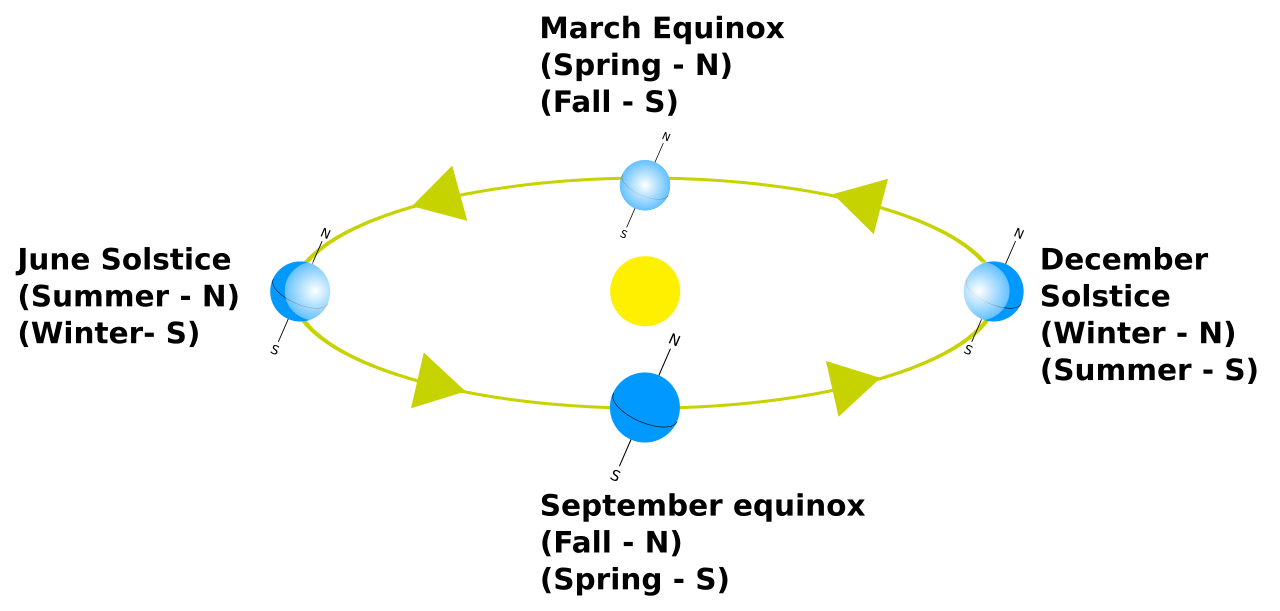

Realize that the sun in on the Celestial Equator for both equinoxes – so we have already drawn the equinox path – it is the Celestial Equator. (Note that this step needs to be slightly altered at the north and south poles where the Celestial Equator is on the horizon.) Drawing the portion of the Celestial Equator that is below the horizon is very useful for latitudes near the poles. The Celestial Equator should be drawn from the east point on the horizon, cross the observer's meridian, and connect to the west point on the horizon. Thus, it should intersect the observer's meridian at an altitude of 90° minus the observer's latitude.

The Celestial Equator is 90° away from both celestial poles. If the observer is in the southern hemisphere the SCP will be on the observer's meridian above the south point at an altitude equal to the observer's latitude. If the observer is in the northern hemisphere the NCP will be on the observer's meridian above the north point at an altitude equal to the observer's latitude. This allows one to take into account the observer's latitude. Draw in the Appropriate Celestial Pole.8.One should begin with a horizon diagram and follow the procedure below:.Mismatch for Cells Connected in Parallel.
Solstice and equinox animation series#
Impact of Both Series and Shunt Resistance.Applying the Basic Equations to a PN Junction.Solar Radiation Outside the Earth's Atmosphere.Í., “ Computing the solar vector”, Solar Energy, vol. C., López-Moratalla, T., and Lara-Coira, M. Cooper, “ The absorption of radiation in solar stills”, Solar Energy, vol. The various ways of calculating the declination angle are graphed below using declination.py python code. Radians dMeanAnomaly = 6.2400600+ 0.0172019699*dElapsedJulianDays ĭEclipticLongitude = dMeanLongitude + 0.03341607*sin( dMeanAnomaly ) + 0.00034894*sin( 2*dMeanAnomaly )-0.0001134 -0.0000203*sin(dOmega) ĭEclipticObliquity = 0.4090928 - 6.2140e-9*dElapsedJulianDays +0.0000396*cos(dOmega) ĭSin_EclipticLongitude= sin( dEclipticLongitude ) ĭY = cos( dEclipticObliquity ) * dSin_EclipticLongitude ĭRightAscension = atan2( dY,dX ) if( dRightAscension < 0.0 ) dRightAscension = dRightAscension + twopi ĭDeclination = asin( sin( dEclipticObliquity )*dSin_EclipticLongitude ) ĭElapsedJulian days is the number of days since Januand dDeclination is the resulting declination. These are only needed for concentrators that require more accurate tracking of the sun.įor instance the SPA algorithm 2( ) uses:ĭOmega=2.1429-0.0010394594*dElapsedJulianDays ĭMeanLongitude = 4.8950630+ 0.017202791698*dElapsedJulianDays They are referred to the equinoxes instead so use sin instead of cos.įinally, there are many algorithms for more accurate determinations of declination angle to account for the elliptic and yearly movement of the earth's orbit.


The declination is zero at the equinoxes (March 22 and September 22), positive during the northern hemisphere summer and negative during the northern hemisphere winter. Where d is the day of the year with Jan 1 as d = 1


 0 kommentar(er)
0 kommentar(er)
